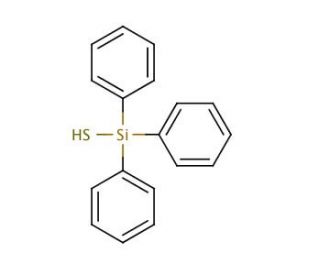

Triphenylsilanethiol (CAS 14606-42-9)
QUICK LINKS
Triphenylsilanethiol, a thiol-based compound, has gained widespread usage across numerous scientific laboratories and research fields. It serves as a key player in polymer synthesis, organometallic compound preparation, and as a reactant in organic synthesis. Additionally, it plays a role in forming self-assembled monolayers (SAMs) on surfaces and acts as a reagent for nanoparticle synthesis. Though the mechanism of triphenylsilanethiol remains not entirely elucidated, it is believed to involve the formation of a thiolate anion, enabling subsequent reactions with other environmental species. Furthermore, the thiolate anion may interact with various compounds, such as metal ions, leading to the formation of organometallic complexes.
Triphenylsilanethiol (CAS 14606-42-9) References
- Quantitative determination of sulfur containing wine odorants at sub-ppb levels. 1. Synthesis of the deuterated analogues. | Kotseridis, Y., et al. 2000. J Agric Food Chem. 48: 5819-23. PMID: 11141254
- Opening of thiiranes: preparation of orthogonal protected 2-thioglyceraldehyde. | Silvestri, MG. and Wong, CH. 2001. J Org Chem. 66: 910-4. PMID: 11430112
- Synthesis and reactions of triphenylsilanethiolato complexes of manganese(II), iron(II), cobalt(II), and nickel(II). | Komuro, T., et al. 2002. Inorg Chem. 41: 5083-90. PMID: 12354041
- Observations on the reactivity of thiyl radicals derived from 3,6-epidithiodiketopiperazine-2,5-diones and related congeners. | Hilton, ST., et al. 2005. Bioorg Med Chem Lett. 15: 2239-42. PMID: 15837301
- Synthesis and Characterization of Germanium Coordination Compounds for Production of Germanium Nanomaterials. | Boyle, TJ., et al. 2009. Eur J Inorg Chem. 2009: 5550-5560. PMID: 23555180
- Comparison of Ligand Architecture on Vapor Deposition Precursors: Synthesis, Characterization, and Reactivity of Volatile Cadmium Bis-Amidinate Complexes. | Foody, MJ., et al. 2021. Inorg Chem. 60: 6191-6200. PMID: 33853328
- Site-Selective α-C-H Functionalization of Trialkylamines via Reversible Hydrogen Atom Transfer Catalysis. | Shen, Y., et al. 2021. J Am Chem Soc. 143: 18952-18959. PMID: 34738467
- Photochemical and Electrochemical Applications of Proton-Coupled Electron Transfer in Organic Synthesis. | Murray, PRD., et al. 2022. Chem Rev. 122: 2017-2291. PMID: 34813277
- Insights into the Mechanism of an Allylic Arylation Reaction via Photoredox-Coupled Hydrogen Atom Transfer. | Spielvogel, EH., et al. 2022. J Org Chem. 87: 223-230. PMID: 34882427
- A Change from Kinetic to Thermodynamic Control Enables trans-Selective Stereochemical Editing of Vicinal Diols. | Zhang, YA., et al. 2022. J Am Chem Soc. 144: 599-605. PMID: 34928134
- Studies of high-membered two-dimensional Ruddlesden-Popper Cs7Pb6I19 perovskite nanosheets via kinetically controlled reactions. | Chen, YC., et al. 2022. Mater Horiz. 9: 2433-2442. PMID: 35848594
- Dual Nickel/Photoredox-Catalyzed Asymmetric Carbosulfonylation of Alkenes. | Du, X., et al. 2023. J Am Chem Soc. 145: 12532-12540. PMID: 37249908
- A convergent, stereocontrolled synthesis of C2-symmetrical and pseudosymmetrical sulfur-tethered bis(amino alcohols) | N Aguilar, A Moyano, MA Pericàs, A Riera. 1999. Tetrahedron Letters. 40: 3913-3916.
Ordering Information
| Product Name | Catalog # | UNIT | Price | Qty | FAVORITES | |
Triphenylsilanethiol, 5 g | sc-253782 | 5 g | $122.00 |
